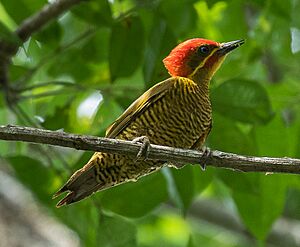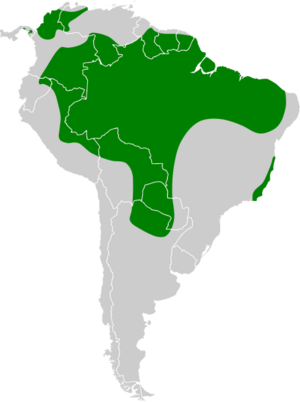Golden-green woodpecker facts for kids
Quick facts for kids Golden-green woodpecker |
|
|---|---|
 |
|
| A male golden-green woodpecker at Darién, Panama | |
| Conservation status | |
| Scientific classification | |
| Genus: |
Piculus
|
| Species: |
chrysochloros
|
 |
|
The golden-green woodpecker (Piculus chrysochloros) is a colorful bird that belongs to the woodpecker family. You can find it in Panama and most countries in South America, but not in Chile or Uruguay. These woodpeckers are known for their bright feathers and their ability to find food by pecking at trees.
Contents
Understanding Woodpecker Types
Scientists group animals into different types, and it can sometimes be tricky! For the golden-green woodpecker, there are six main types, called subspecies. These are like different versions of the same bird, often found in different places.
The main subspecies are:
- P. c. xanthochlorus
- P. c. capistratus
- P. c. laemostictus
- P. c. paraensis
- P. c. polyzonus
- P. c. chrysochloros
Some scientists also think the golden-green woodpecker might be closely related to the yellow-browed woodpecker.
What the Golden-Green Woodpecker Looks Like
The golden-green woodpecker is about 18 to 27 cm (7.1 to 10.6 in) long. That's about the length of a ruler! It weighs between 55 to 91 g (1.9 to 3.2 oz), which is similar to a small apple.
Males and females look very similar, but their heads are a bit different.
Male and Female Colors
Male golden-green woodpeckers have a red cap from their forehead to the back of their neck. They also have olive green feathers around their eyes and on the sides of their neck. Below this, they have a pale yellow stripe and a short red patch on their cheek. Their chin and upper throat are yellow.
Female golden-green woodpeckers do not have any red on their heads. Their forehead and the back of their neck are olive green. Their cheek area is olive-brown.
Both male and female adults have olive green feathers on their upper bodies. Their wing feathers are a darker olive-brown, and their tail is also dark olive-brown. Their undersides are a pale yellow-buff color with olive-brown stripes. They have a dark gray or black beak, white or bluish-white eyes, and grayish-green legs.
Young Woodpeckers
Young golden-green woodpeckers are usually not as bright as the adults. The stripes on their undersides are also not as clear.
Subspecies Differences
Some subspecies have slightly different colors:
- P. c. xanthochlorus is smaller and brighter yellow. Its female has a yellow cap.
- P. c. capistratus is very large and a darker olive green. It has less red on its cheek and a striped throat. Its undersides are greenish-white instead of yellow-buff.
- P. c. paraensis is a medium-sized woodpecker. Its cheek stripe, throat, and undersides are a cinnamon-buff color. Males of this type have a green cheek patch, not red. Females have a greenish-yellow cap.
- P. c. laemostictus is large and quite dark. It has a plain whitish throat.
- P. c. polyzonus is also large. It has a pale yellow cheek stripe and throat, and its undersides are yellow.
Where They Live and What They Like
The golden-green woodpecker lives in many different places across South America and Panama.
Their Homes Across the Land
- P. c. xanthochlorus lives in eastern Panama, northern Colombia, and northern Venezuela.
- P. c. capistratus is found from southeastern Colombia, south through eastern Ecuador into northern Peru, and east through the Guianas into Brazil (north of the Amazon River).
- P. c. laemostictus lives from eastern Peru and northern Bolivia, east to central Brazil (south of the Amazon).
- P. c. paraensis is found in northeastern Brazil, especially around Belém.
- P. c. polyzonus lives in southeastern Brazil, between the states of Bahia and Rio de Janeiro.
- P. c. chrysochloros is found in central and southern Brazil, eastern Bolivia, western Paraguay, and northern Argentina.
Favorite Places to Live
These woodpeckers live in many types of wooded areas. This includes wet forests, rainforests, and forests where trees lose their leaves. They also live in more open areas like grassy plains with trees, pastures, and clearings.
They can be found from sea level up to about 650 m (2,100 ft) in some areas, but usually stay below 300 m (1,000 ft) in Ecuador.
Woodpecker Behavior
Movement
Golden-green woodpeckers stay in the same area all year round. They do not migrate.
Feeding Habits
These woodpeckers usually look for food in the middle and upper parts of the forest trees. They often search alone or in pairs. Sometimes, they join groups of different bird species that are also looking for food.
They find their food by picking insects off surfaces. They also peck and dig into wood to reach prey. While their full diet isn't known, they definitely eat ants and termites.
Reproduction and Life Cycle
The breeding season for the golden-green woodpecker changes depending on where they live. In Colombia, they have been seen breeding between February and March. In Argentina, breeding has been recorded in September.
They make their nests by digging a hole in a tree. They might also use the nests of insects that live in trees. We don't know how many eggs they lay, how long the eggs take to hatch, or how long it takes for the young birds to leave the nest. We also don't know much about how the parents care for their babies.
Vocalization
The golden-green woodpecker's song sounds like a series of about 15 rough, hoarse notes. Some people describe it as sounding like a "hysterically crying baby."
Conservation Status
The IUCN (International Union for Conservation of Nature) has listed the golden-green woodpecker as a species of "Least Concern." This means they are not currently in danger of disappearing.
They live across a very large area, and there are at least half a million adult birds. Even though their numbers might be slowly going down, there are no immediate threats that worry scientists. You can find them in many protected areas, and while they might be rare in some places, they are quite common in others.
Images for kids
-
Piculus chrysochloros by William Swainson, 1820



